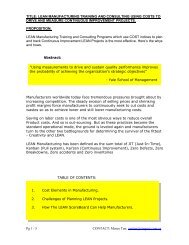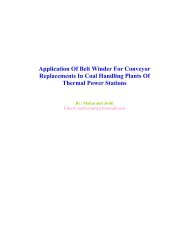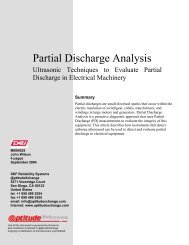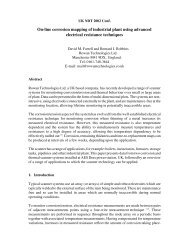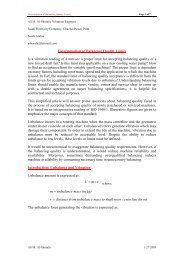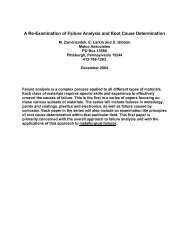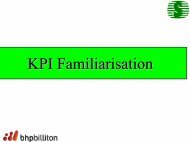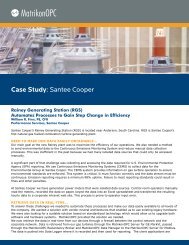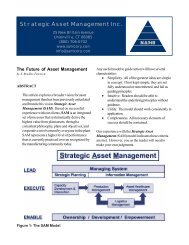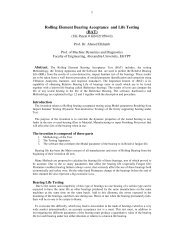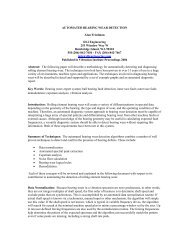Path Forward to a Profit-Centered Maintenance Operation - Plant ...
Path Forward to a Profit-Centered Maintenance Operation - Plant ...
Path Forward to a Profit-Centered Maintenance Operation - Plant ...
Create successful ePaper yourself
Turn your PDF publications into a flip-book with our unique Google optimized e-Paper software.
Maximizing <strong>Maintenance</strong><br />
<strong>Operation</strong>s for <strong>Profit</strong><br />
Optimization:<br />
The Journey <strong>to</strong> <strong>Maintenance</strong> Excellence<br />
February 2002<br />
Establishing a Strategy for <strong>Profit</strong>-<strong>Centered</strong> <strong>Maintenance</strong><br />
By<br />
The <strong>Maintenance</strong> Excellence Institute<br />
____________________________________________________________<br />
Division of Ralph W. Peters and PEOPLE Inc.
The <strong>Maintenance</strong> Excellence Institute<br />
Maximizing <strong>Maintenance</strong> <strong>Operation</strong>s for <strong>Profit</strong> Optimization Page 2<br />
Part IV: <strong>Path</strong> <strong>Forward</strong> <strong>to</strong> a <strong>Profit</strong>-<strong>Centered</strong> <strong>Maintenance</strong> <strong>Operation</strong><br />
Ralph W. “Pete” Peters<br />
The <strong>Maintenance</strong> Excellence Institute<br />
Division of Ralph W. Peters and PEOPLE Inc.<br />
6809 Foxfire Place, Suite 100<br />
Raleigh, North Carolina 27615<br />
919-846-6019<br />
RalphPetePeters@aol.com<br />
http://www.PRIDE-in-<strong>Maintenance</strong>.com<br />
Introduction: Part IV provides a recommended strategy used successfully by The <strong>Maintenance</strong><br />
Excellence Institute for manufacturing maintenance operations, as well as operations in both the<br />
public and private sec<strong>to</strong>rs including pure facilities maintenance operations, healthcare maintenance and<br />
even major contract maintenance providers where in house maintenance has been “contracted out” or<br />
privatized. This part defines three key elements that help turn improvement opportunities in<strong>to</strong> visible<br />
profit-centered results. These elements all contribute directly <strong>to</strong> profit optimization and include how <strong>to</strong>:<br />
1. Determine and quantify benefits and savings<br />
2. Improve craft productivity, the most valuable resource<br />
3. Define a path forward strategy <strong>to</strong> implement improvement opportunities<br />
This section summarizes the many direct and indirect savings opportunities and illustrates how one of<br />
those opportunities; increased craft productivity can be included as gained value. It shows how just one<br />
of many best practice areas from The Scoreboard for <strong>Maintenance</strong> Excellence; effective shop level<br />
planning and scheduling provides more than a 5 <strong>to</strong> 1 return on the investment for just one planner<br />
position for a 20 person craft work force. When maintenance becomes truly profit-centered, ranging<br />
from attitudes <strong>to</strong> actions, the profit optimization process has another very real element <strong>to</strong> include in the<br />
final tally.<br />
Determine and Quantify Benefits and Savings: Potential savings (both tangible and intangible) must<br />
be estimated and established at their most realistic levels. <strong>Maintenance</strong> must be given the best practice<br />
<strong>to</strong>ols, the people resources, and capital investments <strong>to</strong> address the improvement opportunities and in<br />
turn are held accountable for results.<br />
There are a number of key areas where direct savings, cost avoidances and gained value can be<br />
established, documented.<br />
a. Gained value from increased craft labor utilization/effectiveness due <strong>to</strong> increases in wrench<br />
time<br />
b. Gained value from increased craft labor performance/efficiency<br />
c. Gained value of clerical time reductions for supervisors, planners, engineering and admin staff<br />
d. Value of asset/equipment uptime<br />
e. Value of facility availability or cost avoidance from be non-available<br />
f. Value of MRO materials and parts inven<strong>to</strong>ry reduction<br />
g. Value of overall MRO materials management improvement<br />
h. Value of overall maintenance costs reductions with equal or greater service levels<br />
i. Value of increased facility and equipment life and net life cycle cost reduction<br />
j. Value of increased direct labor utilization (production operations)<br />
k. Value of operations productivity increases (production operation)<br />
____________________________________________________________<br />
Ralph W. Peters and PEOPLE Inc.
The <strong>Maintenance</strong> Excellence Institute<br />
Maximizing <strong>Maintenance</strong> <strong>Operation</strong>s for <strong>Profit</strong> Optimization – Page 3<br />
Craft Productivity: Let’s look at one example related <strong>to</strong> craft productivity. Surveys consistently show<br />
that wrench time (craft utilization) within a reactive, fire fighting maintenance environment is within<br />
the range of 30 <strong>to</strong> 40 percent. This means that for a ten hour day there is only four hours of actual<br />
hands-on, wrench time. Typically, low craft utilization is due <strong>to</strong> no fault of the craft work force. Most<br />
of the lost craft labor productivity can be attributed <strong>to</strong> the following reasons:<br />
1. Running from emergency <strong>to</strong> emergency; a reactive, fire fighting operation<br />
2. Waiting on parts and finding parts or part information<br />
3. Waiting on other information, drawings, instructions, etc.<br />
4. Waiting for the equipment <strong>to</strong> be shut down<br />
5. Waiting on rental equipment <strong>to</strong> arrive<br />
6. Waiting on other crafts <strong>to</strong> finish their part of the job<br />
7. Travel <strong>to</strong>/from job site<br />
8. Lack of effective planning and scheduling<br />
9. Make-ready, put away, clean up, meetings, troubleshooting, etc.<br />
The Most Valuable Resource: <strong>Maintenance</strong> operations that continue <strong>to</strong> operate in a reactive, run-<strong>to</strong>failure,<br />
fire fighting mode and disregard implementation of <strong>to</strong>day’s best practices will continue <strong>to</strong> waste<br />
their most valuable asset and very costly technical resource - craft time. Best practices such as effective<br />
maintenance planning/scheduling, preventive/predictive maintenance, more effective s<strong>to</strong>rerooms and<br />
parts support all contribute <strong>to</strong> proactive, planned maintenance and more productive hands on, “wrench<br />
time”.<br />
An improvement in actual wrench time from 40% <strong>to</strong> 50% represents a 25% net gain in craft time<br />
available and a significant gained value. When we are able <strong>to</strong> combine gains in wrench time with<br />
increased craft performance when doing the job we increase our <strong>to</strong>tal gain in craft productivity.<br />
Measuring and improving overall craft productivity can be a key component <strong>to</strong> justify an effective<br />
CMMS and other investments for maintenance improvement.<br />
Gained Value of 10% in Wrench Time: What if through better planning and scheduling, good parts<br />
availability and having equipment available <strong>to</strong> fix it on a scheduled basis, we are able <strong>to</strong> increase actual<br />
wrench time by 10 percent What is the value <strong>to</strong> us if we get that 10 percent increase across the board<br />
for a 20- person crew operating now at 40% wrench time being paid an average hourly rate of $18 per<br />
hour.<br />
Total Craft Hours Available and Annual Craft Labor Costs<br />
Hrs.<br />
20 Crafts x 40 wk. x 52 wks./yr. = 41,600 Craft Hours Available<br />
41,600 Craft Hours @ $18/hr. = $748,800 Craft Labor Cost/Year<br />
____________________________________________________________<br />
Ralph W. Peters and PEOPLE Inc.
The <strong>Maintenance</strong> Excellence Institute<br />
Maximizing <strong>Maintenance</strong> <strong>Operation</strong>s for <strong>Profit</strong> Optimization – Page 4<br />
Wrench Time and Actual Costs Per Hour at Various Levels of Craft Utilization<br />
Level of<br />
Craft Utilization<br />
Average Wrench<br />
Time Hours<br />
Per Craft Position<br />
Total Wrench<br />
Time (Hours)<br />
Actual Hands On<br />
Cost Per Hour<br />
30% 12,480 $60.00 624<br />
40% 16,640 $45.00 832<br />
50% 20,800 $36.00 1040<br />
60% 24,960 $30.00 1248<br />
70% 29,120 $25.71 1456<br />
*80% 49,920 $22.50 1664<br />
*85% 35,360 $21.18 1768<br />
90% 37,440 $20.00 1872<br />
100% 41,600 $18.00 2080<br />
Note: Maximum possible craft utilization is ≈ 80 <strong>to</strong> 85 percent considering paid holidays, vacation<br />
time, breaks, clean-up, employees meetings, craft training, etc. See Figure IV-1<br />
For Example: With effective planning and scheduling we can achieve at a minimum a 10 point<br />
improvement in craft utilization. From a baseline of 40 percent up <strong>to</strong> a level of 50 percent we in effect<br />
get a 25 percent increase in craft capacity for actual work.<br />
• Total Hours Gained in Wrench Time: 4,160 hours gained<br />
20,800 hours @ 50% - 16,640 hours @40% = 4,160 hours gained<br />
• Total Gain in Equivalent Number of Crafts Positions: 5<br />
4,160 Hours Gained<br />
832 Average Wrench Time Hours @ 40% = 5 Equivalent Craft Positions<br />
• Total Gained Value of 5 Equivalent Positions: $280,800<br />
hrs. Wks $18.00<br />
5 equivalents x 40 wk. x 52 yr. x hr. = $187,200 Gained Value<br />
Valuable Craft Time Can Slip Away: With only a 10% improvement up <strong>to</strong> 50% wrench time, the 20-<br />
person craft work force operating at 40 percent craft utilization baseline, the 4,160 hours of wrench<br />
time gained represents a 25 percent increase in craft labor capacity. The maintenance best practice for<br />
planning and scheduling requires dedicated a planner(s). An effective maintenance planner in turn can<br />
support and plan for 20 <strong>to</strong> 30 crafts positions. With only a 10 percent increase in craft utilization for a<br />
20-person craft work force, can be much more than a 5 <strong>to</strong> 1 return <strong>to</strong> offset a maintenance planner<br />
position.<br />
Figure IV-1 on the next page illustrates “How Your Valuable Craft Time Can Slip Away”.<br />
____________________________________________________________<br />
Ralph W. Peters and PEOPLE Inc.
The <strong>Maintenance</strong> Excellence Institute<br />
Maximizing <strong>Maintenance</strong> <strong>Operation</strong>s for <strong>Profit</strong> Optimization – Page 5<br />
Figure IV-1<br />
How Your Valuable Craft Time Can Slip Away<br />
Total Available Days: 52 Weeks/Yr x 5 Days/Week<br />
= 260 Available Days Maximum<br />
Without Overtime<br />
260 Total Days – 10 Days Holiday Per Year = 250 Days<br />
Now Available<br />
250 Days/Yr –15 Vacation/Sick Days<br />
Average Per Year = 235 Days<br />
Now Available<br />
235 Days/Yr – 15 Days Break<br />
Time* Per Year = 220<br />
Days/Year<br />
Now Available<br />
Note*: 15 min x 2 breaks/day<br />
= ½ hour/day x 235 days<br />
=117.5 hours ÷ 8 hours/day<br />
=15 Total days Per Year<br />
Bot<strong>to</strong>m Line:<br />
220 days ÷260<br />
days = .846<br />
= 85% +/-<br />
Craft Time<br />
Available<br />
for Work<br />
Various Levels of Wrench Time<br />
85% = Maximum Craft Utilization<br />
70% = World-Class Wrench Time<br />
60% = Very Good Wrench Time<br />
50% = Good Wrench Time<br />
40% = Above Average Wrench Time<br />
30% = Average Wrench Time<br />
20% = On Call: The Maytag Repairman<br />
10% = On Call: The Maytag Repairman<br />
____________________________________________________________<br />
Ralph W. Peters and PEOPLE Inc.
The <strong>Maintenance</strong> Excellence Institute<br />
Maximizing <strong>Maintenance</strong> <strong>Operation</strong>s for <strong>Profit</strong> Optimization – Page 6<br />
The planner(s) position is normally recruited internally and not replaced. The additional craft capacity<br />
and productive craft time that is gained can be used <strong>to</strong>:<br />
! Accomplish deferred repairs<br />
! Accomplish PMs being neglected<br />
! Reduce overtime<br />
! Accomplish work done by contrac<strong>to</strong>rs<br />
! Reduce need <strong>to</strong> add or replace staff<br />
Develop and Implement Strategic Action Plan: Successful implementation of maintenance best<br />
practices is the objective and represents the culmination of doing an effective overall evaluation and<br />
having a well-defined plan of action developed from recommendation that evolve from it. The results<br />
from the evaluation sets the stage for a prioritized plan of action. A project team is then defined and a<br />
more detailed project plan with tactical and operational tasks/plans <strong>to</strong> support strategic plan<br />
implementation. The major phases of a strategic plan of action may look something like the following:<br />
Phase I:<br />
Phase II:<br />
Phase III:<br />
Phase IV:<br />
Phase V:<br />
Phase VI:<br />
Phase VII:<br />
Establish Strategic Plan of Action<br />
• Evaluate and Select CMMS<br />
• CMMS Implementation<br />
• Best Practice Development and Implementation Planning<br />
• Initiate Effective Planning and Scheduling<br />
• MRO Materials Management and Procurement Improvements<br />
• S<strong>to</strong>reroom Modernization<br />
• More Effective Preventive and Predictive <strong>Maintenance</strong> Technology<br />
Develop and Establish <strong>Maintenance</strong> Planning Function<br />
Evaluate, Select and Implement CMMS<br />
Develop and Implement S<strong>to</strong>reroom Modernization, MRO Improvements<br />
Implement Other <strong>Maintenance</strong> Best Practices<br />
Measure <strong>Maintenance</strong> Performance and Validate Benefits with <strong>Maintenance</strong><br />
Excellence Index (MEI in Part V)<br />
Continuous <strong>Maintenance</strong> Improvement<br />
The Real Work is Implementation: Successful implementation is the ultimate objective that provides<br />
maximum value <strong>to</strong> your maintenance operation. It is very important <strong>to</strong> remember the 90-10 Rule for<br />
projects. Ninety percent of the real project work comes during the implementation and normally the<br />
easiest part is planning which is only ten percent of the work. Never underestimate the resources<br />
needed for implementation. Begin implementation with clearly defined plans for each area of the<br />
strategic plan as well as tactical and operational level tasks and actions. Never begin implementation<br />
without methods in place <strong>to</strong> validate results especially if you use external consulting resources.<br />
External resources at times might “borrow your watch <strong>to</strong> tell you the time and then walk off with your<br />
watch before implementation”.<br />
____________________________________________________________<br />
Ralph W. Peters and PEOPLE Inc.
The <strong>Maintenance</strong> Excellence Institute<br />
Maximizing <strong>Maintenance</strong> <strong>Operation</strong>s for <strong>Profit</strong> Optimization – Page 7<br />
<strong>Profit</strong> Optimization is About Total <strong>Operation</strong>s Success and <strong>Profit</strong>: Part IV has provides a<br />
recommended strategy used successfully for manufacturing maintenance operations, as well as<br />
operations in both the public and private sec<strong>to</strong>rs and even for major contract maintenance providers. It<br />
has looked at three key elements that help turn improvement opportunities in<strong>to</strong> visible profit-centered<br />
results and support <strong>to</strong> profit optimization and include how <strong>to</strong>:<br />
1. Determine and quantify benefits and savings<br />
2. Improve craft productivity, the most valuable resource<br />
3. Define a path forward strategy <strong>to</strong> implement improvement opportunities<br />
There are many direct and indirect savings opportunities and we illustrated how <strong>to</strong> capture one of those<br />
opportunities; increased craft productivity as gained value. Just one of many best practice areas from<br />
The Scoreboard for <strong>Maintenance</strong> Excellence; effective shop level planning and scheduling by a single<br />
planner can provides more than a 5 <strong>to</strong> 1 return on the investment for a 20 person craft work force.<br />
When maintenance becomes truly profit-centered, ranging from attitudes <strong>to</strong> actions, the profit<br />
optimization process has another very real element <strong>to</strong> include in the final tally for the <strong>to</strong>tal operation.<br />
You Can Get Maximum Value from Your <strong>Maintenance</strong> <strong>Operation</strong>: You can maximize your <strong>to</strong>tal<br />
maintenance operation for profit optimization by successful implementation of strategic, tactical and<br />
operation level actions. To find out the best approach for your organization, for help with planning the<br />
pilot evaluation and <strong>to</strong> receive a complete copy of this five-part series contact.<br />
Ralph “Pete” Peters<br />
The <strong>Maintenance</strong> Excellence Institute<br />
6809 Foxfire Place, Suite 100<br />
Raleigh, NC 27615<br />
E-Mail: RalphPetePeters@aol.com<br />
Office: 919-846-6019<br />
Fax: 919-846-9804<br />
http://www.PRIDE-in-<strong>Maintenance</strong>.com<br />
____________________________________________________________<br />
Ralph W. Peters and PEOPLE Inc.
The <strong>Maintenance</strong> Excellence Institute<br />
Maximizing <strong>Maintenance</strong> <strong>Operation</strong>s for <strong>Profit</strong> Optimization – Page 8<br />
Bio of Ralph W. “Pete” Peters<br />
President and founder for Ralph W. Peters and PEOPLE Inc. a consulting firm with three divisions for <strong>to</strong>tal<br />
operations improvement; The <strong>Maintenance</strong> Excellence Institute (maintenance), The Manufacturing Excellence<br />
Institute (manufacturing) and The Institute for Public Service Excellence (governmental). His practical<br />
engineering experience and technical leadership in the maintenance, manufacturing and governmental<br />
productivity consulting fields has helped hundred of operations achieve manufacturing operations success and<br />
maintenance excellence in plant, fleet and facility maintenance operations.<br />
His scope of experience in governmental operations productivity has firmly established his personal capabilities<br />
and that of The Institute for Public Service Excellence <strong>to</strong> support value added government services. Pete is a<br />
senior member of the Institute of Industrial Engineers, the Association of Facility Engineers and the Society of<br />
<strong>Maintenance</strong> and Reliability Professionals He has been involved in manufacturing operations management,<br />
systems implementation, facilities management, maintenance and governmental productivity consulting for more<br />
than 30 years. He is retired from the US Army Corps of Engineers/NC Army National Guard (1995) with 28 years<br />
of service and serving in Viet Nam and during Desert S<strong>to</strong>rm.<br />
Pete is author of the upcoming books; <strong>Profit</strong>-<strong>Centered</strong> <strong>Maintenance</strong>: The New Millennium Strategy for<br />
<strong>Maintenance</strong> Excellence and PRIDE in <strong>Maintenance</strong>. He is edi<strong>to</strong>r/primary author for The Guide <strong>to</strong> Computerized<br />
<strong>Maintenance</strong> Management Systems, Scientific American Newsletters LLC, author of the maintenance chapters in<br />
The Warehouse Management Handbook and The Future Capable Company from Tompkins Press and John<br />
Wiley’s new Handbook of Industrial Engineering, 3 rd Edition. A recognized leader in the areas of implementing<br />
manufacturing and maintenance best practices, profit-centered maintenance, performance measurement,<br />
productivity improvement for government operations and providing value-added <strong>to</strong>tal operations consulting, He<br />
is also the author of over 200 articles and publications and as a frequent speaker has delivered presentations on<br />
manufacturing and maintenance-related <strong>to</strong>pics worldwide. He received his BSIE and MIE from North Carolina<br />
State and is a graduate of the US Army Command and General Staff Course and the Engineer Officers Advanced<br />
Course.<br />
Clients from the manufacturing and maintenance sec<strong>to</strong>rs have included operations in the petrochemical,<br />
aerospace, manufacturing, mining, pharmaceutical, hand-<strong>to</strong>ol manufacturing, utilities and au<strong>to</strong>motive industries,<br />
in addition <strong>to</strong> construction fleet management, public transit operations and facilities management for healthcare,<br />
educational and governmental facility complexes.<br />
____________________________________________________________<br />
Ralph W. Peters and PEOPLE Inc.



